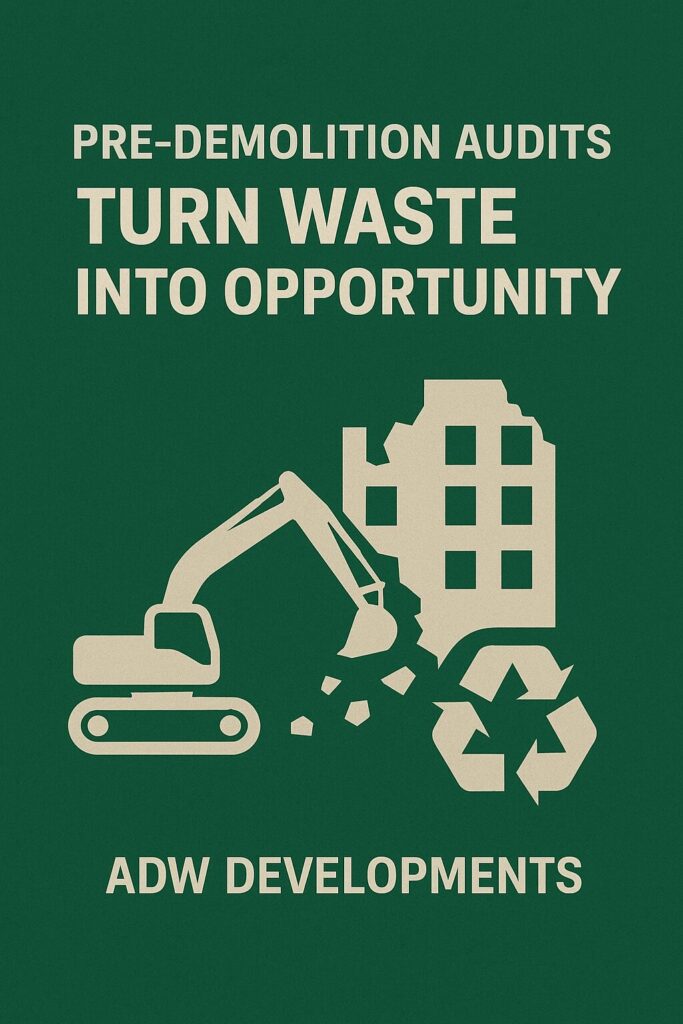As established in all of our previous articles, the construction and demolition sector generates vast amounts of waste, with valuable materials often lost to landfill. As the shift towards a circular economy accelerates, Pre-Demolition Audits (PDAs) are emerging as a key solution.
Today’s article explores the crucial role of Pre-Demolition Audits in shifting from a waste-centric to a resource-centric model. It outlines what PDAs involve, the benefits they deliver for sustainability and commercial performance, and how they underpin a truly circular construction industry. By assessing the material potential of buildings before demolition, we can unlock value, minimise environmental impact, and build a more resource-efficient future.

What is a Pre-Demolition Audit (PDA)?
A Pre-Demolition Audit, sometimes referred to as a Pre-Deconstruction Audit or Material Inventory, is a systematic survey carried out before demolition or major refurbishment works begin. Its purpose is to identify, quantify, and assess the condition of materials that could be reused, recycled, or recovered.
Unlike traditional waste audits, which focus on disposal, PDAs are forward-looking, aiming to keep materials in circulation and reduce the need for virgin resources.
Typical components include:
- Material identification: An inventory of materials, from structural elements like steel and concrete to internal finishes, fixtures, and fittings.
- Quantity estimation: Measuring the volume or weight of each identified material.
- Condition assessment: Evaluating material quality and potential for reuse (e.g. timber beams suitable for direct reuse, concrete suitable for recycled aggregate).
- Hazardous material identification: Detecting asbestos, lead paint, or other hazardous substances requiring safe handling and removal.
- Logistics and feasibility: Considering how materials can be safely recovered, stored, transported, and reprocessed, as well as market opportunities for reuse.
- Diversion recommendations: Outlining practical strategies to maximise value and minimise waste through reuse, recycling, or energy recovery.
The outcome is a detailed report that serves as a roadmap for sustainable demolition or deconstruction, guiding project teams in optimising material recovery.
Why Pre-Demolition Audits Matter for a Circular Economy
The traditional take–make–dispose model is no longer viable. In contrast, the circular economy seeks to keep resources in use for as long as possible, extract maximum value, and regenerate products and materials at the end of each life cycle. PDAs are a cornerstone of this transition for five key reasons:
1. Maximising Resource Recovery and Value Retention
Buildings are material banks. Without a PDA, valuable materials are often crushed or mixed with waste, losing their potential for recovery. Auditing enables targeted deconstruction and reuse, reducing the need for virgin materials and preserving embodied carbon.
2. Reducing Landfill Waste and Environmental Impact
Construction and demolition waste makes up a significant share of total waste. By diverting recoverable materials from landfill, PDAs cut pollution, lower methane emissions, and support national waste reduction targets.
3. Delivering Economic Value
While PDAs require upfront investment, they often deliver substantial savings and new revenue streams:
- Reduced landfill and disposal costs.
- Income from the sale of reclaimed materials.
- Lower procurement costs through reuse.
- Enhanced ESG credentials and client confidence.
4. Supporting Compliance and Regulation
Across the UK and Europe, policy increasingly supports circular practices. In London, for example, GLA Policy SI 7 mandates a Circular Economy Statement for major developments. PDAs provide the data needed to demonstrate compliance and leadership.
5. Driving Innovation and New Business Models
PDAs create opportunities for deconstruction specialists, material marketplaces, and circular supply chains. These emerging industries generate green jobs and promote long-term economic resilience.
FAQs
What is a Pre-Demolition Audit?
A PDA is a systematic survey carried out before demolition or refurbishment to identify materials for reuse, recycling, or recovery.
How do PDAs support the circular economy?
They keep materials in circulation for longer, reducing the need for virgin resources and cutting waste to landfill.
What are the financial benefits?
Reduced disposal fees, new revenue from salvaged materials, and lower procurement costs, alongside enhanced sustainability credentials.
Are PDAs mandatory in the UK?
Not universally, but many local authorities require them for major developments, and national policy strongly encourages their use.
What materials can be recovered?
Common recoverables include steel, concrete, timber, glass, fixtures, and fittings, depending on their condition and reuse potential.
As seen throughout this article, Pre-Demolition Audits mark a pivotal shift in how the construction sector approaches end-of-life planning. By identifying and valuing materials before demolition, they transform waste into opportunity, unlocking environmental, economic, and social value.
With sustainability standards tightening and resources under pressure, PDAs are set to become a defining feature of responsible construction. Embedding this approach through collaboration across developers, designers, contractors, and recyclers will be key to realising its full potential. Ultimately, the Pre-Demolition Audit is more than a compliance exercise; it is a blueprint for resilience, efficiency, and a truly circular built environment.
At ADW Developments, we help clients integrate circular thinking from the outset, turning compliance into opportunity. Contact us today to learn how we can support your next sustainable project.
